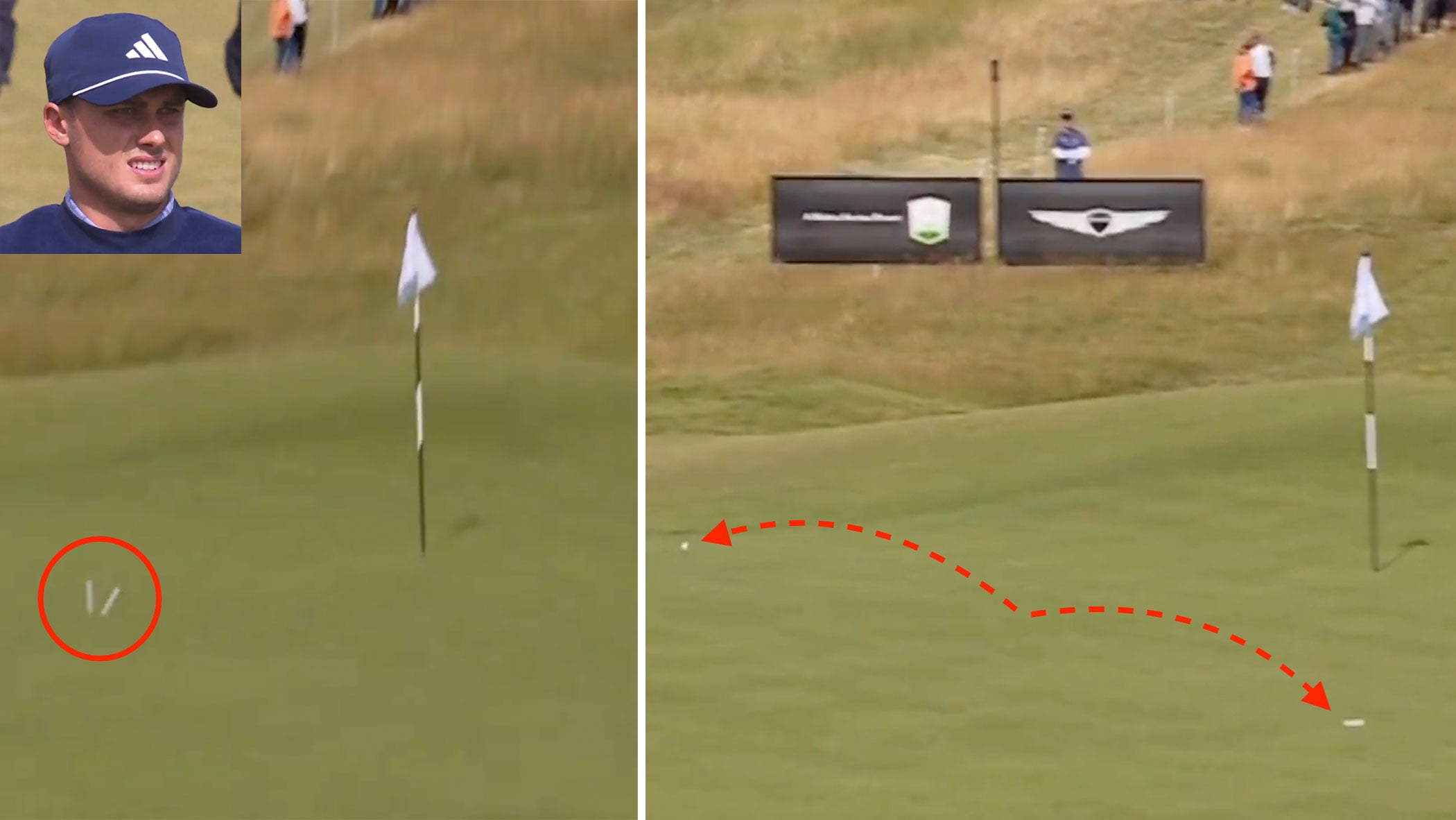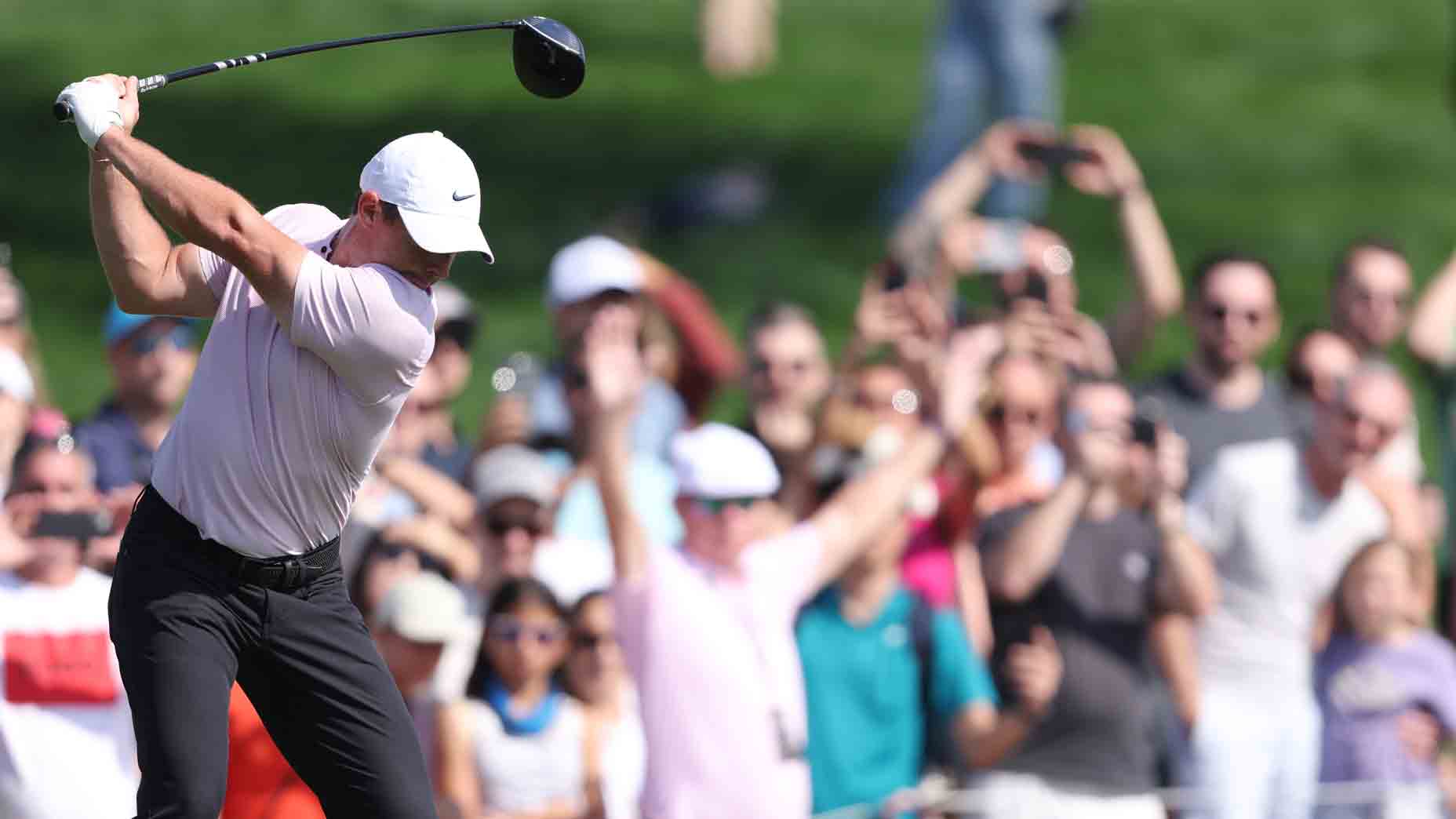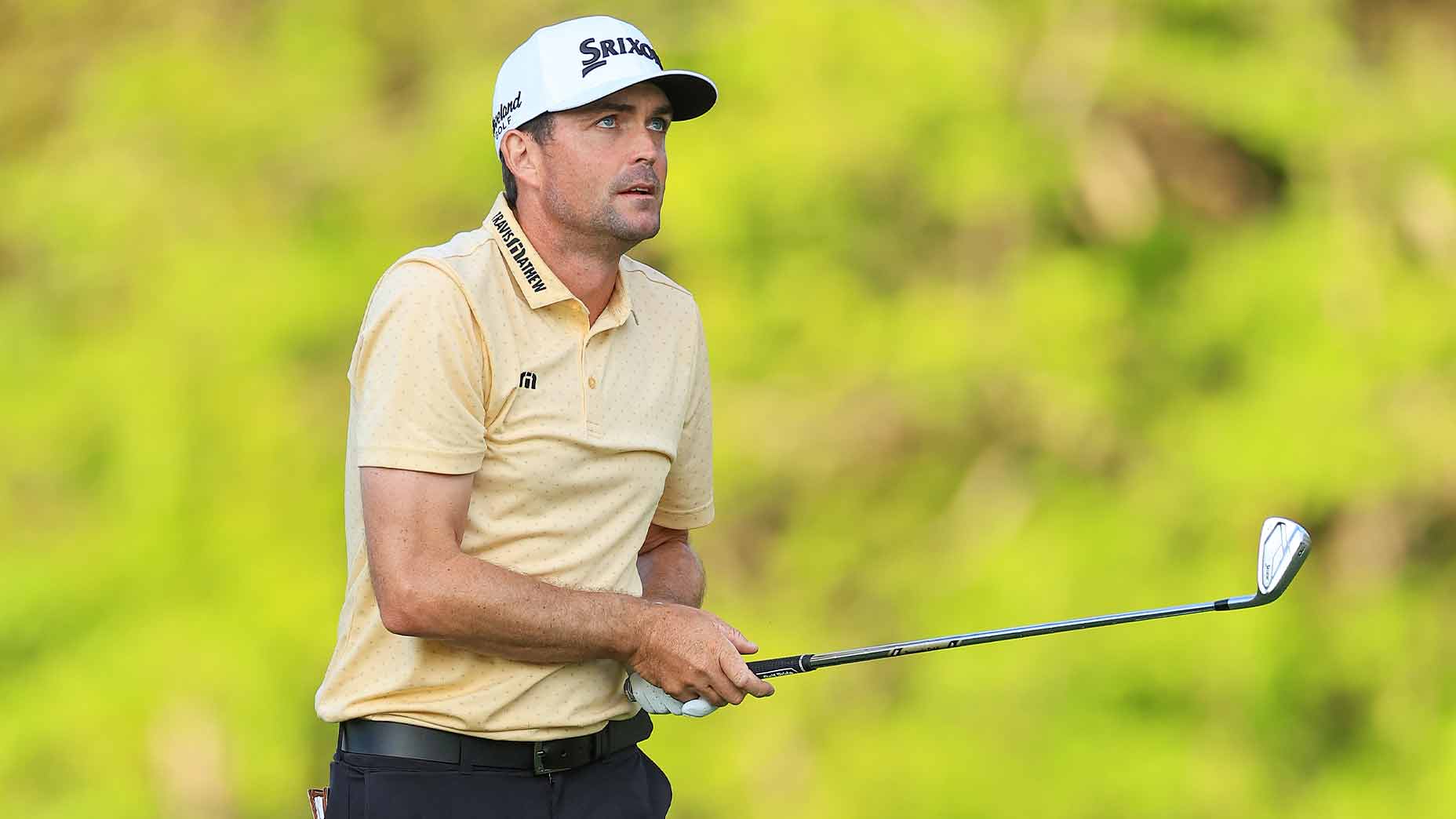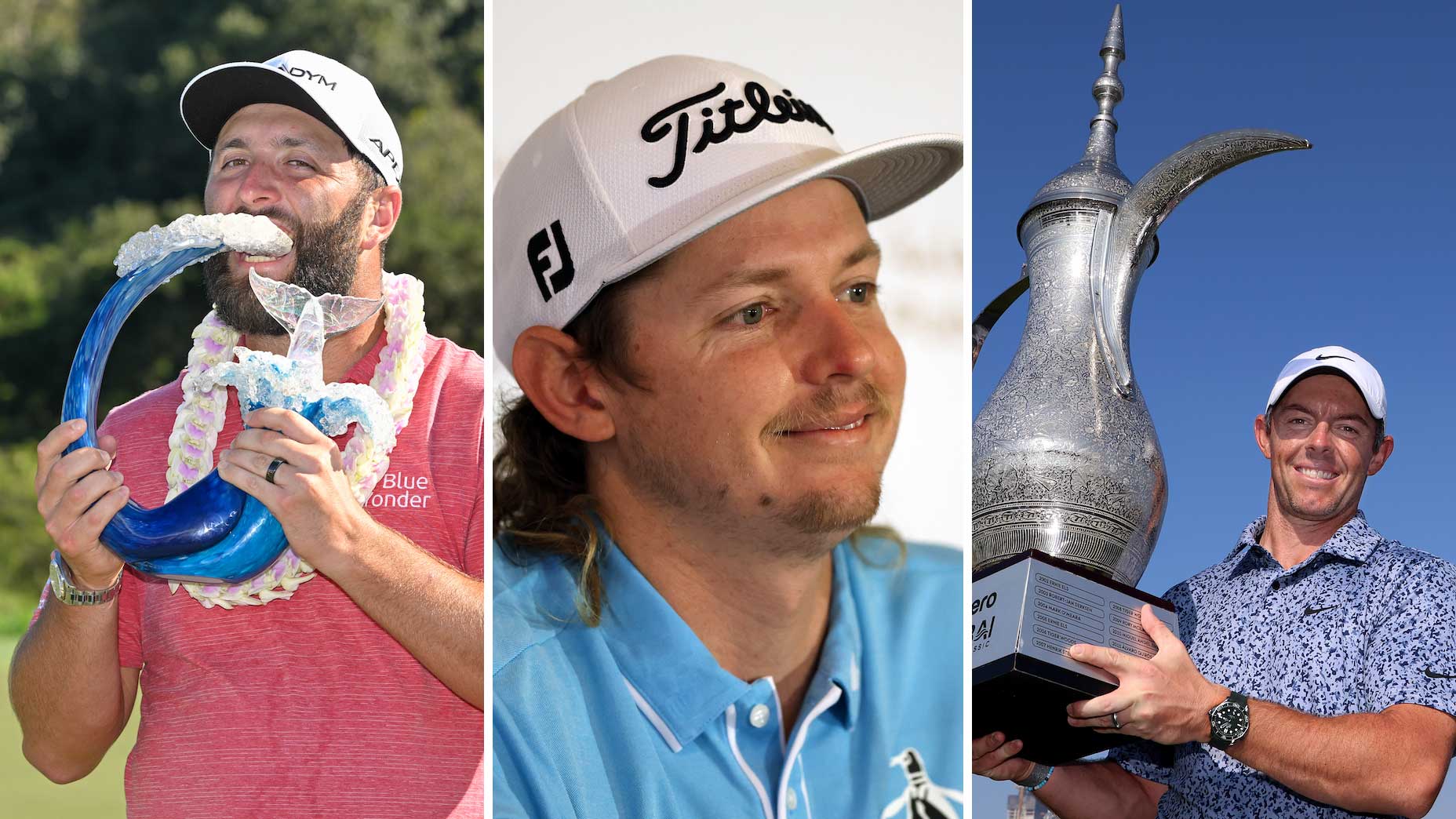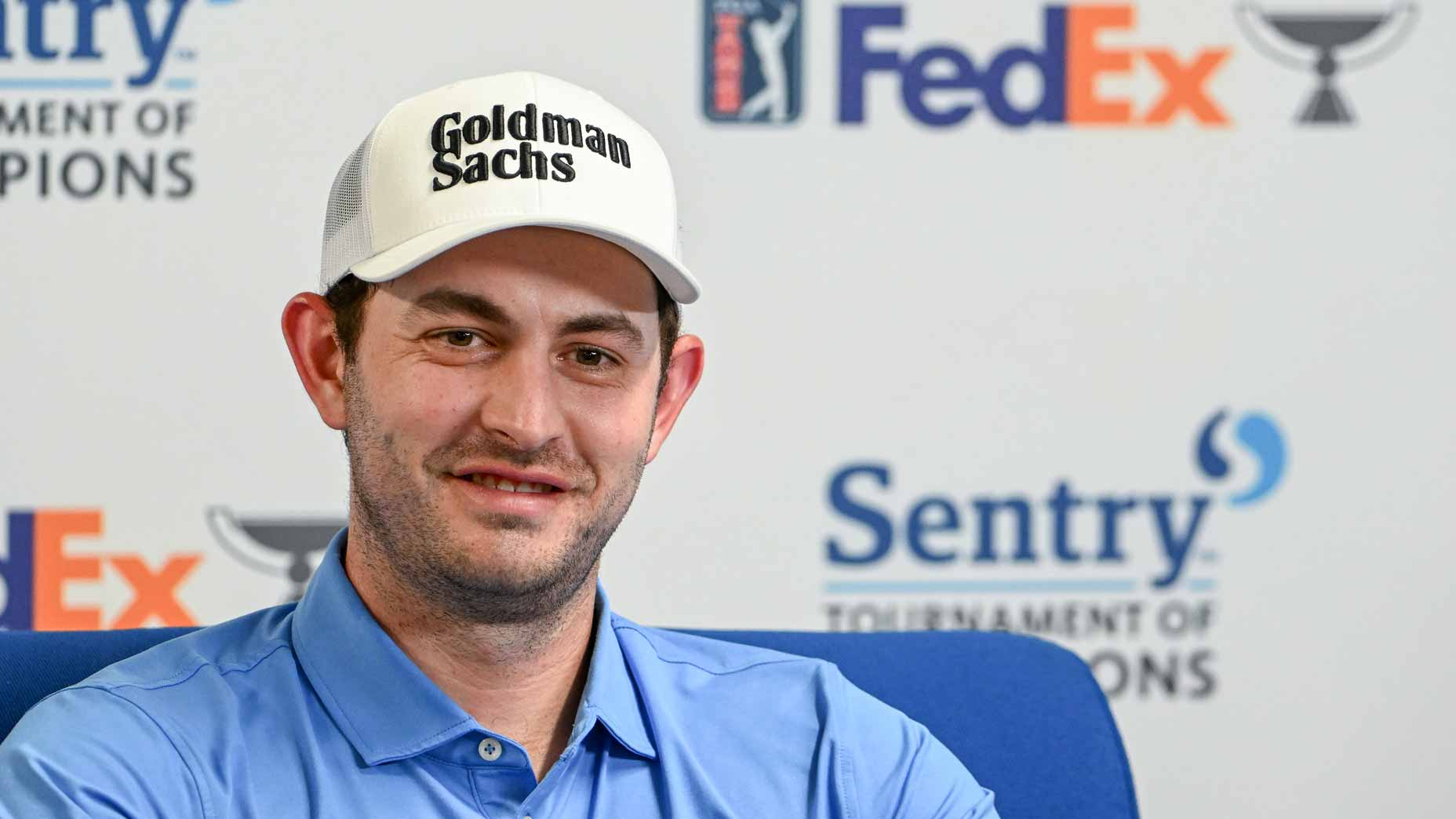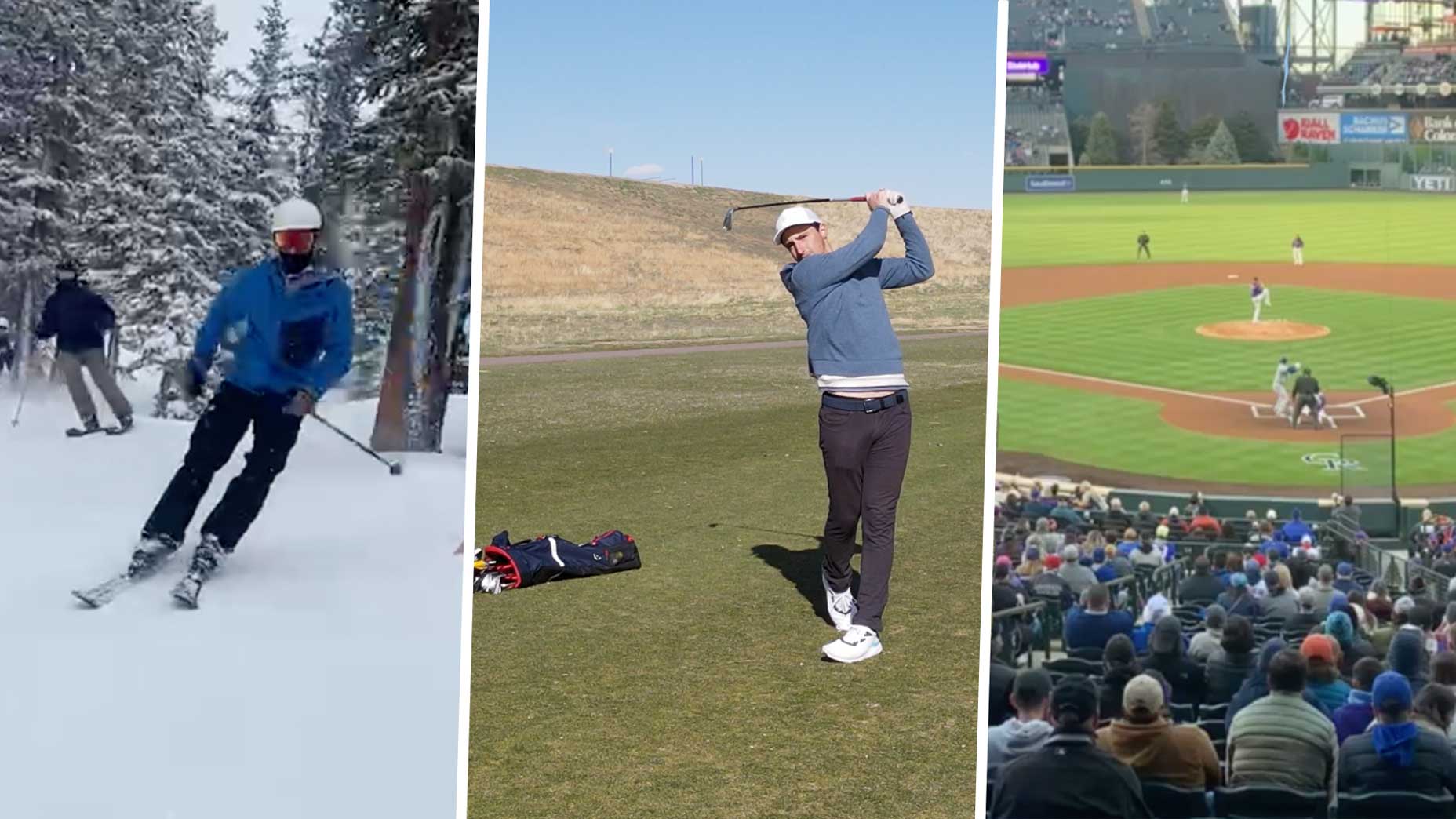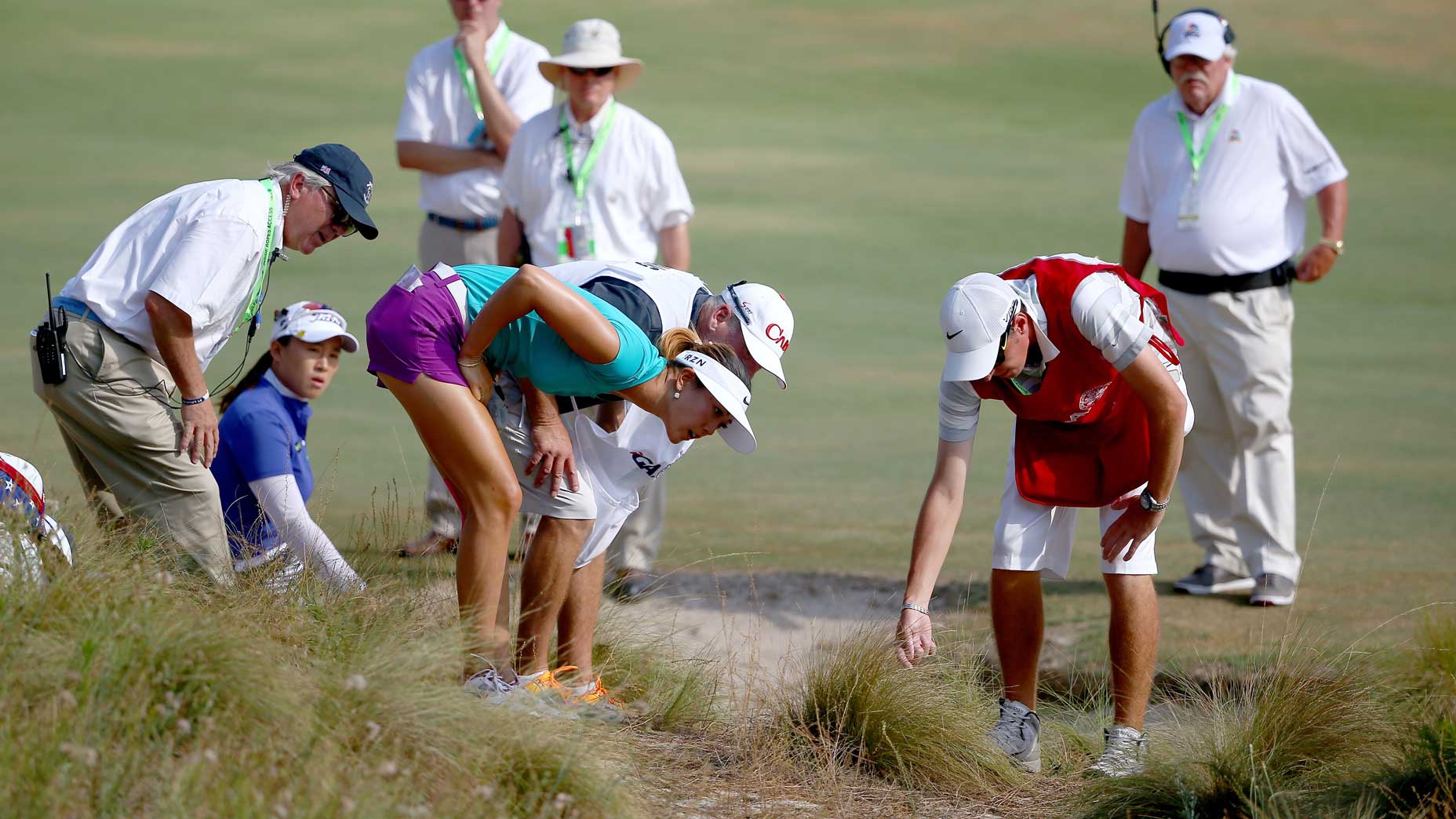Raising Rory: What McIlroy’s lifelong coach learned from raising a golf legend
- Share on Facebook
- Share on Twitter
- Share by Email

Rory McIlroy and Michael Bannon have worked together for more than two decades.
Getty Images
On the Wednesday before the Memorial Tournament in Ohio, Rory McIlroy faced down the press. We are, by and large a motley crew — made motlier by the challenges of technology. Some toiled from the masked-up confines of the media center; others of us called in from further afield, eager to pick the brain of the world No. 1 golfer.
McIlroy hadn’t been quite his relentless on-course self since the Tour’s return to the spotlight. T32. T41. T11. Fine. Hardly keeping up with the torrid top-10 pace we’ve grown accustomed to.
To get him back on track, McIlroy called for the in-person services of his most-trusted advisor: lifelong coach Michael Bannon. In an era of high-profile, brand-building swing coaches, Bannon stands out because he doesn’t stand out — he spends most of his time at home on the east coast of Northern Ireland, connected to McIlroy by intermittent visits and a bond of trust built up over two-plus decades.
Bannon flew to the States to see his client — and his friend. “It was good to see him,” McIlroy said. “It was nice to spend some time with him and get some good work done.” He pointed out that while he can send plenty of swing videos across the Atlantic, they hardly replicate the real thing, then murmuring something about elbow fold and external rotation. It was clear: McIlroy felt good having an in-person consult with the man who knows his golf swing better than anyone. Comfort comes in different forms for different people.
The remarks about Bannon hit particular home for me because I’d had a long chat on the phone just a couple weeks earlier with the very same man, happily settled at home. He was nominally there to promote his new Golf Channel show, Breaking into the Game: Juniors. But as we got going he just seemed eager to chat, and left with a standing invitation for a round of golf.
The original conversation aired on our Drop Zone podcast, and you can listen to that here, or read on for a lightly edited version.
Dylan Dethier (that’s me!): Michael, to set the stage for us, I’d love to know: What is the culture of junior golf in Northern Ireland? I’m curious how you think it might compare or contrast to, say, junior golf in the United States?
Michael Bannon: Well, I was at Holywood Golf Club for 16 years, and then I moved to Bangor Golf Club, which wasn’t too far away, for 13 years. We tried to introduce a culture where the juniors were like just little people. We got the members to buy into that and they were happy to see junior golfers around the club — around the pro shop, around the practice grounds, playing golf. They’d give us a lot of times on the golf course where they could play.
One of the big things that we have in Northern Ireland is competition from an early age. And lots, lots of that at different age groups. And I think that’s one of the things that maybe other places don’t have just as much. I saw a lot of it, especially in Bangor.
And what do you think that that competition at an early age does to kids? Does it normalize that sense of being up against each other?
Bannon: Yes, it does. It gives them that competitive edge. But I think also what it does is it takes a lot of the golf away from the range and away from the technical side and actually into playing the game very early, getting out on the golf course, learning to play against their opponents, learning to play the course more than they would on the practice range.
So then take me to the moment: When did you first meet Rory McIlroy? Do you have a first memory of seeing him play golf?
Bannon: Well, Rory and his mom and dad lived on the same street, about 200 yards from where I lived at the time. And his dad was a friend of mine long before Rory was born. He was a really good golfer in the club in Holywood. And he used to bring Rory up and set him in the little stroller. And Rory would watch his dad hit golf balls. And I think that was the very early genesis of his golf swing — watching his dad swing and just soaking it in like a sponge.
That’s where I really would see Rory. And then very early, even when he was in nappies, he would hit a plastic ball with a plastic club when he was like two years of age.
Sure — I think we’ve all seen those clips now of young Rory doing his thing and watching his dad. And even now it’s striking actually seeing a side-by-side of Gerry’s golf swing and Rory’s golf swing because maybe at first glance they don’t look like the same thing. But when you slow it down, they sure have a lot of similarities.
Bannon: Yes, there are similarities, especially the nice flow. Gerry had always a nice flow in his golf swing; it was nice and syrupy and loose. Rory had some of that, too. He still does have that.
McIlroy Snr 🆚 McIlroy Jnr.
— DP World Tour (@DPWorldTour) May 4, 2020
Like Father like Son.#DunhillLinks pic.twitter.com/3T4ylGCPiw
So when did you first start working with Rory in a more official capacity as his coach?
Bannon: Well, Rory joined the golf club when he was eight years of age. The normal age to join the golf club in Holywood was about 12. But Rory was so far advanced that at eight years of age, they allowed him in to play golf and play junior competition golf.
So I started to look at him then and talk to him and give him little hints and teach him. But very gently, because Rory had a lot of good things going on. He really had a good pattern, a good movement, and he could do things with the golf ball, even at that age. He could move it about, he could hit it low, high. A little bit like Seve Ballesteros, he had a sense of where the ball was going to go and he could just change his angle and change his club face and make the ball do what he wanted to do.
He was just a great young child, he was very happy and, you know — it just would have done your heart good to watch him. Michael Bannon
I remember reading that he was the youngest-ever member admitted to the club when he was eight.
Bannon: Yes. They asked me, you know, “Should he be a member?” And I said, “Yes, of course, his golfing abilities are fantastic.” As long as he can look after himself and he’s safe on the golf course, which is very important. And his parents said yes, and there you are. He was a member!
And what was he like at that point? Did he love the game of golf? Was he an impudent little kid? Or did he carry himself pretty well already?
No, he was never impudent, he was just a great young child, he was very happy and, you know — it just would have done your heart good to watch him. How he loved golf and how he went out and played. And he was just a good kid, you know, and everybody loved him ‘round the club. And he was a talking point because he was so young and so talented. But he was just a good young guy, y’know?
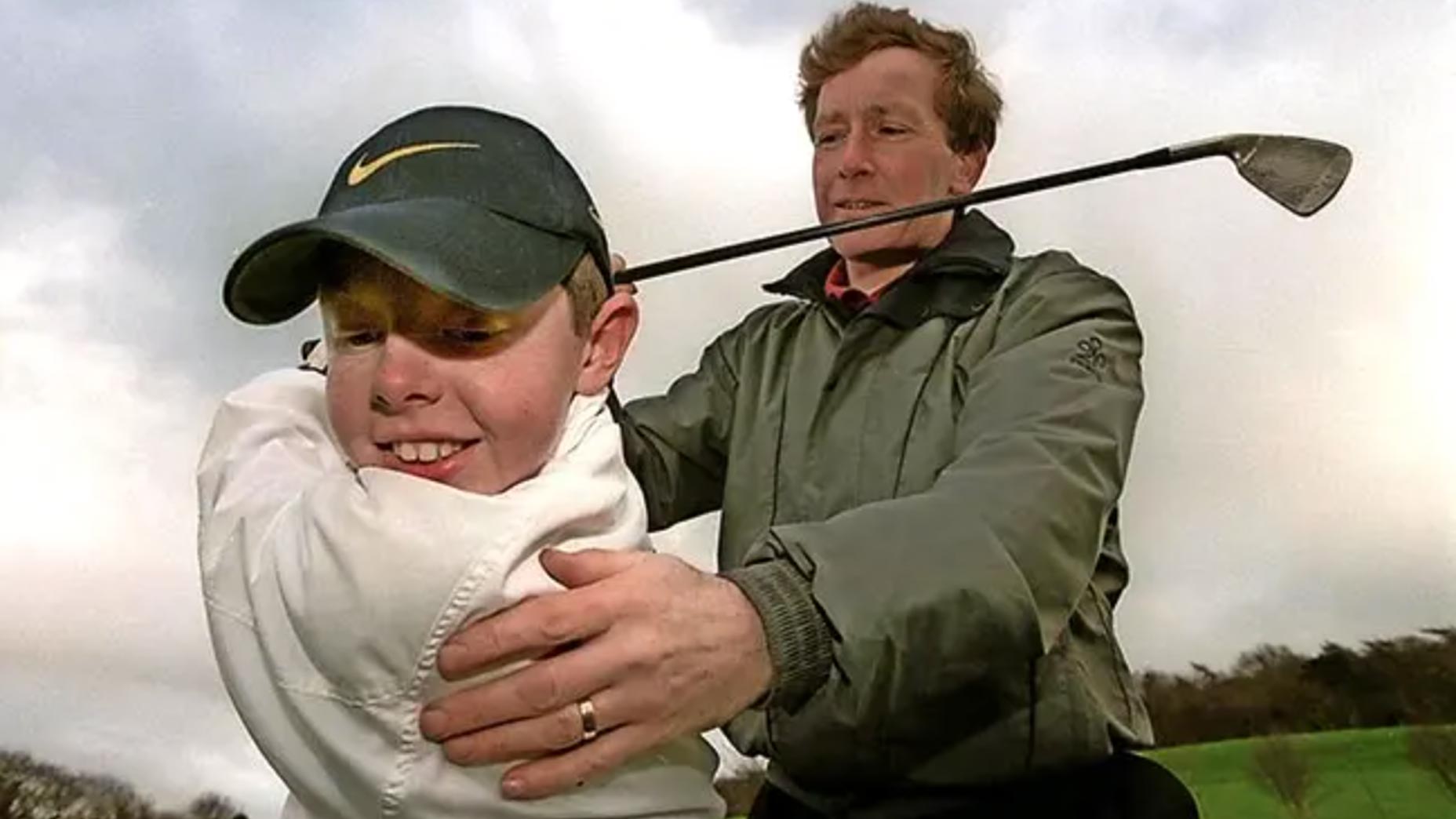
You talked about that contrast of being on the range versus being out on the golf course. Did he have a mix? Did he spend more time in one place or the other?
Bannon: We just talked about this one day, maybe about a year ago. And I said, “What do you think, Rory? What was the percentage?” And he said it was probably 80-90 percent on the course and then 10-20 percent practice.
But in the early days, it was all in the course. He played and played and played. He played nine holes, played again. He never really hung about the pro shop that much. Maybe sometimes on the putting green he would chip and putt there, but it was mainly on the golf course learning the game.
That’s really interesting. And is that something that you would prescribe for other juniors now? I mean, obviously there’s many ways to do it and plenty have gotten to the top being more range rats. But are you a fan in general of juniors getting out on the golf course as much as possible?
Bannon: Yeah, if it’s possible for the juniors to get on the golf courses, and there are some small golf courses, six-hole, nine-hole, short 18-hole, anywhere they can go to play. I think it’s great. You’ve got to play the different conditions. You got to play the different lies. You got to play the rough. All these different things that you’re going to come up against on the golf course. And you don’t always learn them on a flat surface on the range. So for me, playing the game is what the juniors should do. Get out on the course.
And do you remember anything about Rory’s goals at this point? Because now he looks back and says that he always wanted to win all the majors. Do you remember how young he was thinking that big?
Bannon: Yes. I mean, Rory would come into the shop with his card. He would always have written, you know, the name of a tournament on the top of the card like the Open or something major. That’s how young he was aspiring to win these massive tournaments. You know, to be able to put a name at the top of the Open or the Masters, something on the top of his card.
So he would be simulating actual golf tournaments when he went out and played.
Yeah, he did. And one of the smarter things that his dad did, which a lot of junior parents should do, was that he adjusted the pars on the golf course. And so if it was a par-4, I mean, Rory was small and he reckoned, okay, the par is really 6 or 7 for that hole. So he would write that on a card.
You know, this is not a competition golf. This is just in, you know, casual golf. So the first could have been a par-6 or 7. Then the next might have been a 6. And they’d do nine holes or whatever. Rory could go ‘round the course under par.
And it was really a smart thing because it gave him the confidence of, “yeah, I was under par today,” — Under par of the course that his dad set up for him. His dad had set the pars on the course.
He learned how to make birdies, I guess, at a very early age.
Bannon: Well, that’s right — not to be afraid to be under par.
What was your working relationship like with Rory’s parents? Because I know that can sometimes be tricky, figuring out who’s going to coach when. What was that whole back-and-forth like?
Bannon: When his dad handed him him over to me, he came into the shop one day and he needed his clubs gripped and I had to take about five or six inches off the clubs and his dad looked at me and he said, “You know more than me, can you look after him?”
So we did it from then on. It was very similar to the way we do it today. A couple of hints on maybe what the faults are, a couple of little antidotes or little changes and then Rory would go and fix it and come back, let me check it again and then we’d go forward from there.
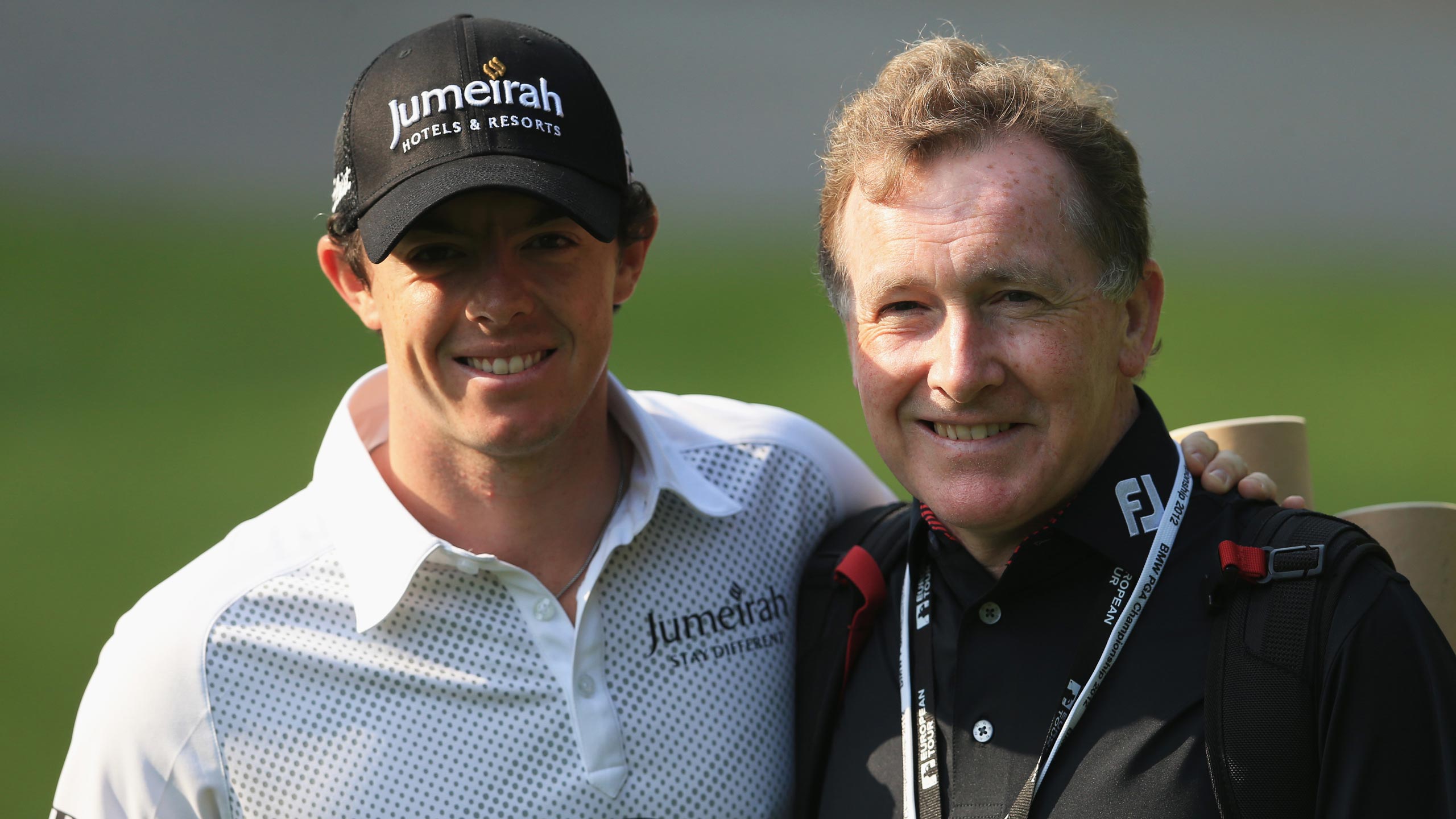
Of course, there’s plenty of talented junior golfers, some more than others, obviously. But what was different about Rory? And did you know it right away?
Bannon: I think I did see it right away that he had something different from other people. You know, he really had a very strong love of the game. And he also had like, a tunnel vision.
He knew was good and we always told them he was good. His parents told him he was great. So did I. And in my coaching, there was never a negative word spoken. We gave him the confidence to actually know that he was good and he just went from there. He was very, very positive. He believed in himself very early on.
Was there a lot of pressure on him from an early age? Not necessarily from his little core group, but from maybe Holywood or from Northern Ireland in general?
No, I didn’t think so. I think any pressure that he really had he probably put on himself. We just took it as it came along and we went with the flow and I just coached him and helped him along.
I mean, in his early teens until he was 18, he was unbelievable. He was just unreal. I mean, if he didn’t win the tournament he was playing in, we thought there was something wrong.
But we never put pressure on him. Maybe that’s just the way we were or we just knew subconsciously that he didn’t need extra pressure — he’s going to do it himself.
Is there any single tournament or maybe even single shot that stands out from that period when he was a young teenager and simply better than anyone else around?
Bannon: It’s hard for me to know; I didn’t go to a lot of the tournaments. But I think he was 13 when he won an under-18 main event at a place called Donaghadee Golf Club. It was the Ulster Boys Championship, you know. And I watched him in the final. The way he swung and the way he managed himself, it was like he was a pro. He was just so good, but so, so advanced for his years. I can’t single out one shot, but I can just say that he got better and better every year as we went along.
I’m always interested when successful people are asked about their combination of talent and hard work versus luck. And I wonder if there’s anything you could point to in Rory’s life that would be considered lucky, or whether his talent and his hard work were just that transcendent?
Bannon: I don’t know. I mean, I suppose you get lucky if you’ve got good parents and his parents were great, they brought them up well. They gave him the confidence and I’m not going to talk about myself, but maybe I was the right person in the right place at the right time. I was lucky, too. It’s just, I can’t really…I don’t really know! I just don’t know.
I guess it’s the perfect recipe, whichever way it is.
Bannon: I mean, I think that’s what you’ve got to say. You know, if it had been different people it might have been different — you just don’t know. It is what it is, and I think there were a lot of good ingredients in the mix.
Well, in football, if a guy is a 6’4 wide receiver and can run a 40-yard dash in four seconds, then that’s a certain type of talent. But if you just look at Rory, especially as a kid, you wouldn’t necessarily know, “Oh, he’s going to be the No. 1 golfer in the world.” Golf is an interesting sport in that way.
Bannon: If you had been there all along and watched, there was a buzz that he created around Holywood Golf Club and the way he played. And you know, Rory would really work very hard on the golf course, learning his game. You talk about talent. I mean, there’s a certain amount of talent and a certain amount of ability to swing a golf club. But he worked very, very hard all those years on his game. And that’s probably one of the major factors in how good he is now.
I was listening to an interview Rory was giving a couple months ago, and he was talking about the importance of junior golfers also playing other sports. And I’m wondering if that’s something that you think is important, that kids should be playing different sports when they’re growing up and not just zeroing in on the game of golf.
Bannon: I think it is important that you can play some team sports. Golf can be a very lonely game. And with team games, it gives you like a camaraderie and it gives you a connection with other people. Young people should always try different sports, and eventually they’ll click on one, you know, they might take up a tennis racket. They might play football, they might play golf, they might play soccer. Somewhere in those years, they’ll say, “Well, this is the one that I like.”
And Rory always liked golf. He did play other sports. But he stuck to the golf.
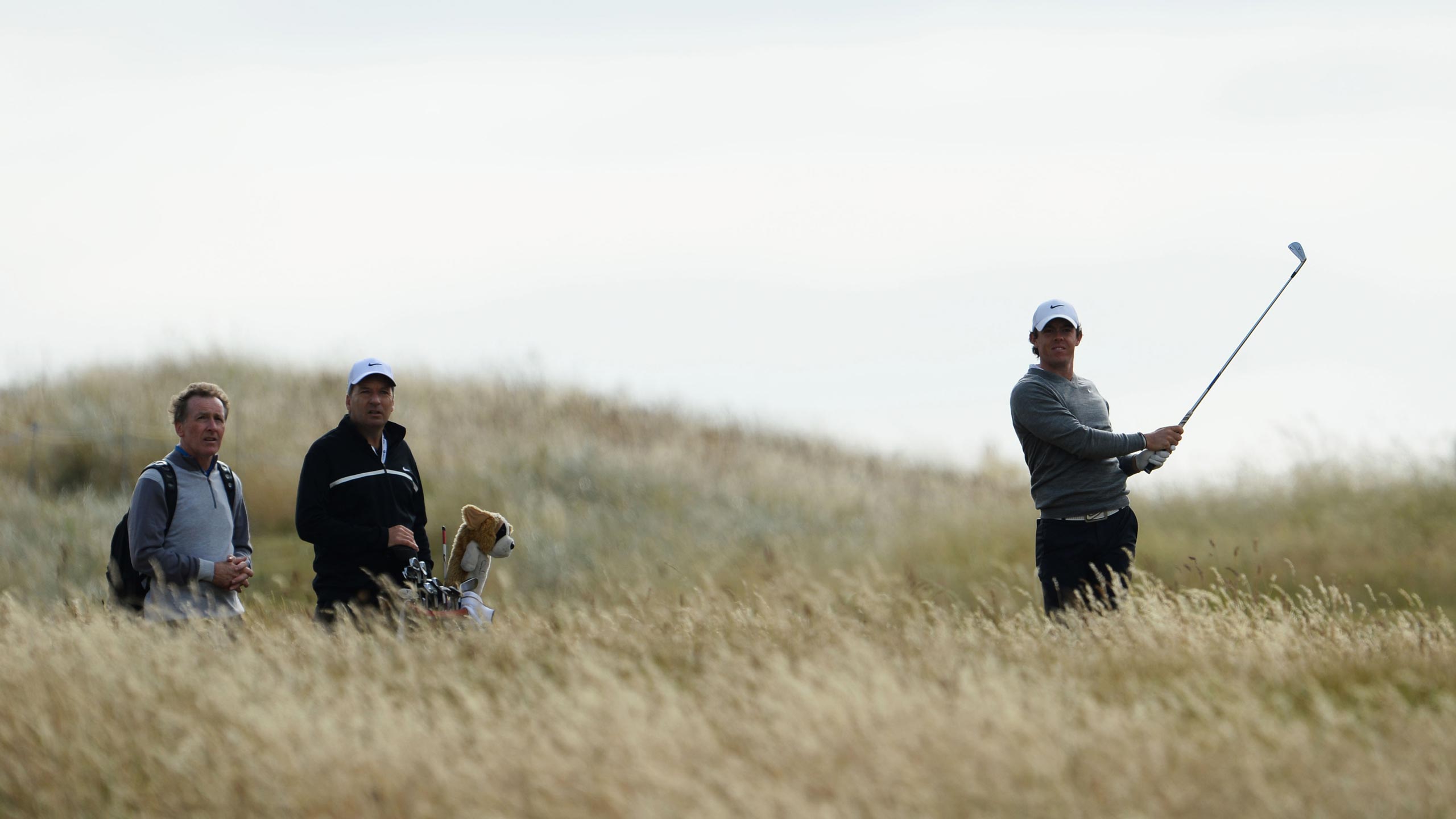
Do you guys always agree about stuff? Do you see eye-to-eye on little tweaks in his golf swing? What kind of a relationship do you have?
Bannon: Sometimes we agree; not always. You know, we chat about it. We actually talk it through quite sensibly. And I’m always the devil’s advocate. If he’s making a swing a certain way, I’ll say, “That’s good for this, but that can be a problem maybe down the line if you’re swinging too much that way.”
We discuss the different parts of the swing, which he’s very knowledgeable about. And we get to a middle ground. I’ve played a lot of golf myself, so I know how difficult the game is. And I know whenever a player settles on a feeling or a certain way, they want to shape the shot, you’ve got to go with that and try your best as a coach to try and manage it. Yeah. It’s not just me coaching him. It’s Rory and I together doing the thing.
Well, that’s what struck me. I mean, completely from the outside, there appears to be a lot of trust. There’s not a need for you to be in the camera shot when he’s hitting balls on the range before a big tournament or anything like that. I wonder if you could talk about that trust a little bit.
Bannon: I think that’s true because all through those years that I coached Rory from eight years of age until he went on the Tour, we had a little system where he would come to me. I would look at the swing, we’d go up and look at it on the V1 system on the computer, we’d have a talk about it, we’d go back down and make a few adjustments, then we’d come back up again and see if it was fixed. Then away he would go.
So it was kind of like a little chat. And at times he would like certain swings. And he’d say, “I like the look of that.” And he’d go back through his old swings or look at some other people’s swings and I would either say, “Yeah, that’s okay to do that,” or, “No, it’s not.” But it was a kind of a partnership, really, with me making sure that he wasn’t going down the wrong track. The relationship is good.

I always am very happy to listen to everything that Rory tells me and only feels because sometimes coaches can’t see everything, you know. You have to get the feelings of the person. You’ve got to see what’s inside their head or what they’re feeling on their take away or they’re top of the backswing or they’re struggling. You’ve got to talk to them and, you know, it’s important to be there.
But then once Rory gets something in his head, you’ve gotta leave him alone. Just let him go.
When you see Rory now, which of these two ideas is more true: Wow, look at how far this guy has come from that kid in Holywood? Or: Wow he’s really the same guy that he was at six years old, eight years old, 10 years old.
Bannon: Well, there’s a lot of that 10-year-old in him, but he’s definitely a very different person now, he’s matured great. And he’s a great learner. I mean, he learns very quickly. From one month to the next, from one tournament to the next, and he soaks it in, he just keeps learning and keeps wanting to get better. I think the big driver is wanting to be better all the time.
Could tell me a little bit about how your work with Rory has affected the way you think about other juniors over time? Has your philosophy shifted at all as you’re working to get juniors into the game, as you focus on in your show?
Bannon: I mean, the show is very simplistic. It’s really like, right down to the baseline. It’s not a lot of rocket science. I don’t take everybody the same. You can’t do that. You’re teaching a person, and if they can’t do it one way maybe there are another two ways or three ways that I’ll tell them and then suddenly something will click and then they’ll be able to do it. One of the big things is working with them, not just reading out a book. And very basic English — don’t confuse them too much.
Some pros might look at it and think, “Oh, that’s very, very simple stuff.” But you’re talking to juniors and trying to get them in the game and you’re showing them some simple things that you might do if you if you took a lesson from it. Hopefully we can get more juniors to play the game on and to enjoy it, because it’s just a fantastic game.
Do you had advice for any parents who are trying to get their kids into the game, who maybe weren’t great players themselves? Is there any universal advice that you have for parents that are curious about starting out?
Bannon: Yeah, I would say to go down to the pro at the golf club and take some good advice from them. And maybe back off a little bit until they get a little bit bigger and then they can become more involved. Take Rory’s parents: they just let Rory play and they just let me do my thing. They weren’t the parents who would get too involved.
It’s interesting because that’s different from the style of Earl Woods, which has become so famous in the golf world. He was extremely present. I’ve seen some of those videos from when Tiger was a kid, and while there was certainly nothing negative about it, Earl and Tiger seemed very close, it was very involved.
Bannon: But that’s the thing — Earl was very good at what he did. He was very knowledgeable and knew exactly what he was doing. It’s a bit like the Williams sisters. Their dad wasn’t a tennis player, but I mean, he knew exactly what he was doing. So you do get the right ingredients sometimes and they work.
But it’s tricky, because if someone who doesn’t necessarily know what they’re doing tries to take pieces of that same exact approach…
Bannon: They shouldn’t be too involved, because the child will get fed up very early on and somebody that could have been a good player won’t bother with it. They’ve got to enjoy themselves and they’ve got to be made to feel welcome.
How important is that that the juniors and that kids enjoy themselves and independently have a love for the game of golf?
Bannon: It’s very important. I mean, people used to say to me, “Johnny or Sarah wants to come back for lessons because they enjoyed it.” It’s not really the lesson. They just want to come back because they enjoyed it. Kids want to enjoy themselves. It’s not like being at school, really. It shouldn’t be that way.
Who are some of the people that were in Rory’s sights along the way? Who was the target — who were the posters in his bedroom?
Bannon: I think Tiger Woods was probably. Early on it was Nick Faldo, and then when Tiger came on the scene, it was Tiger.
One thing that Rory was always able to do: As soon as he beat you, he would move on to the next guy. Who’s better than me? I’m going to beat him. You’ve got to play against people who are better players, beat them and move on.
Do you ever see Rory on the screen or talking to Tiger Woods or being around the greatest golfers in the world, do you ever kind of pinch yourself and say, “Man, how far we’ve come?”
Bannon: All the time. All the time. It just this kind of surreal when you see him with Mr. Jack Nicklaus or Tiger Woods or any of those people that I would have watched, you know. It’s just unbelievable for me to watch him be better than them at times.
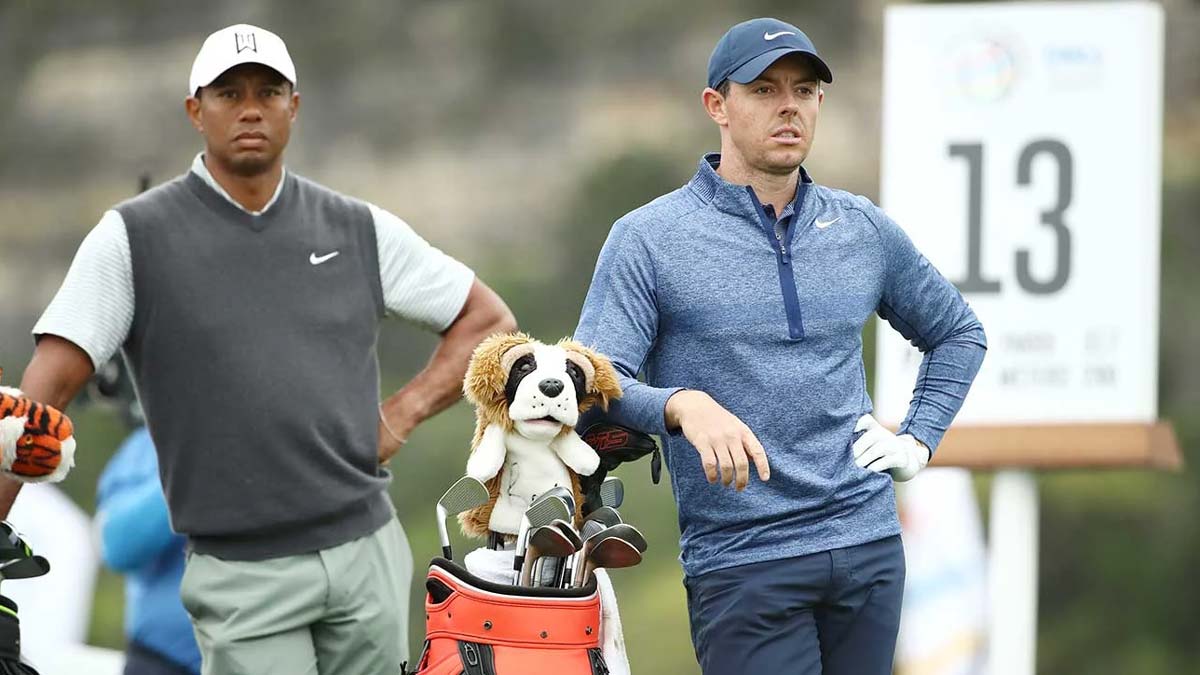
Yeah, well, better than just about everyone right now. But I wonder: Throughout this entire experience, he hasn’t just become a great golfer, but a celebrity — by his own choosing or not. What effect do you think that that has had on him?
Bannon: When you come down to it he is no different, really. He’s older, he’s more mature, but he’s still Rory, he’s just the same person. He’s a very avid learner and reader, and he’s always willing to better himself that way as well as his golf. Sometimes, as you say, you have to pinch yourself whenever you see where he’s gone.
But it’s difficult for me to see like other people because I’ve been there just all along the way. I still see him as Rory, but he’s fantastic, now the way he has developed himself.
He seems keen on keeping in mind where he came from. Certainly you could see it at Portrush last year: How nervous he was on the 1st tee and then, you know, how he made such an emotional charge that second day to try to make the cut. And just what that meant to him.
Bannon: I was there on that second day, and it wasn’t a great day. He was coming in late. The people were still there, but they were only there for one reason: They were there just to see Rory maybe make the cut and do what he did. He was kind of shaken by that. He hadn’t seen that for a while, that the local support was still so strong for him.
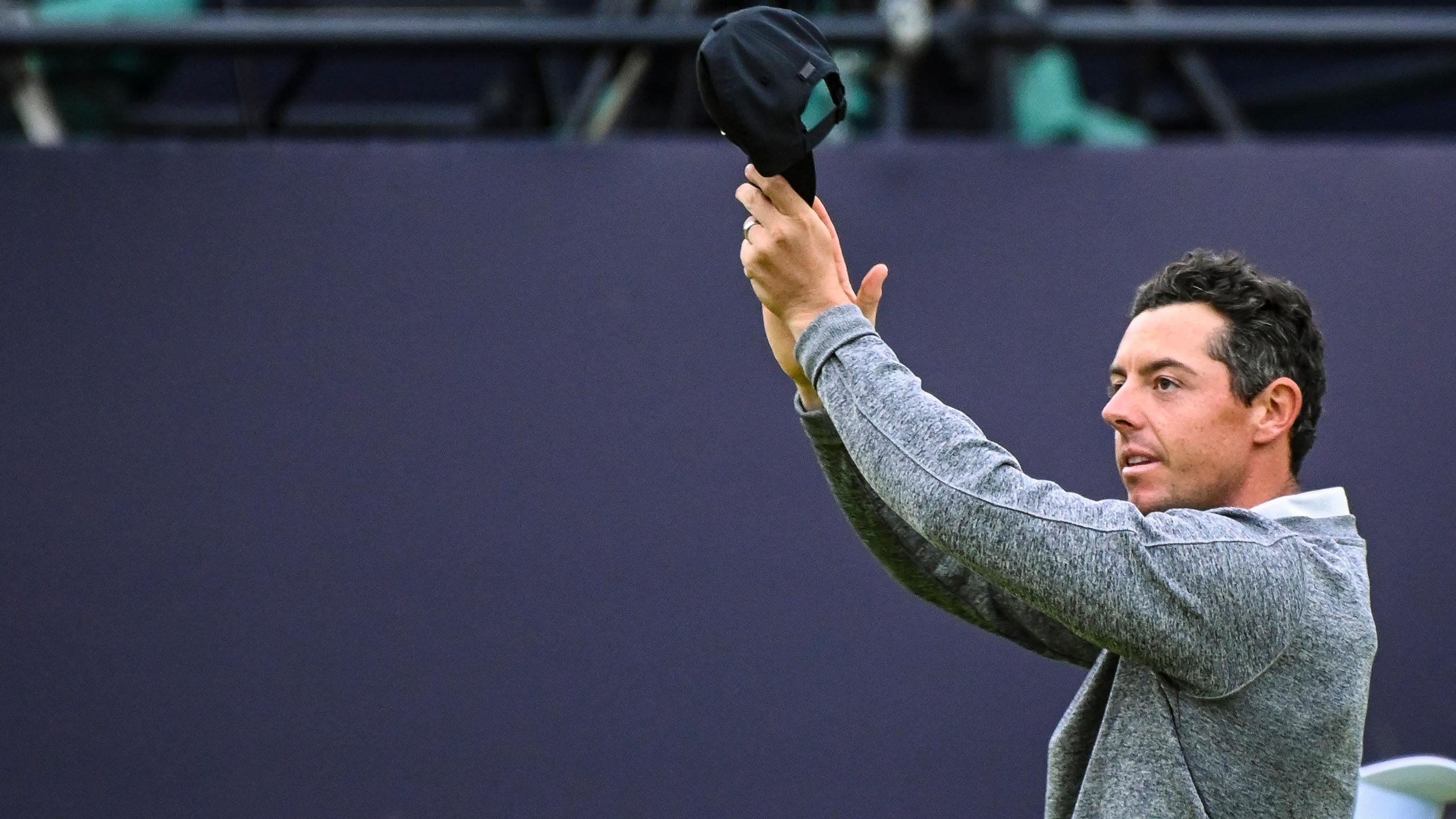
It was amazing to watch. That’s really when I got the full sense of the community’s support. Like you said earlier, that pressure wasn’t necessarily coming from outside — it was still coming from within.
Bannon: That’s right. It was difficult on that 1st tee that first day for him. I think the whole thing just hit him on the tee, the noise and the people around him. But he did make a good charge on the second day. He was just a bit unlucky. A couple of shots would have done it, but there you go.
Tremendous interview. Never heard Rory like this. pic.twitter.com/sBThMqRDXH
— No Laying Up (@NoLayingUp) July 19, 2019
So I wonder then, just to to wrap us up here, if there are any lessons that you have taken from raising Rory to teaching junior golfers everywhere. Are there any big lessons from what worked out so well with Rory?
Bannon: That you need to take your child to a good PGA pro. You need to find somewhere where they can play golf once they get swinging and you’ve got to find someone to look after them who has got patience. Patience is the big thing with children. And they’ve got to enjoy themselves, they’ve got to be put in an environment where they can enjoy themselves. And just let’s see what happens.
Latest In Instruction

Dylan Dethier
Golf.com Editor
Dylan Dethier is a senior writer for GOLF Magazine/GOLF.com. The Williamstown, Mass. native joined GOLF in 2017 after two years scuffling on the mini-tours. Dethier is a graduate of Williams College, where he majored in English, and he’s the author of 18 in America, which details the year he spent as an 18-year-old living from his car and playing a round of golf in every state.

